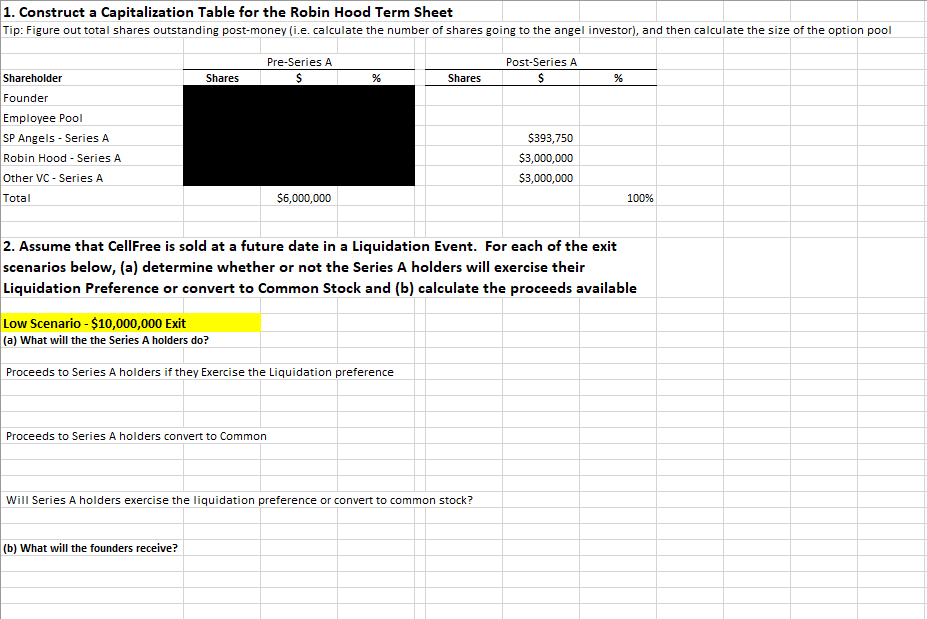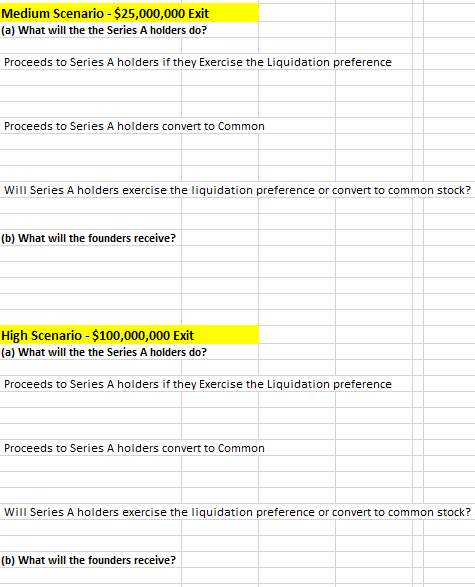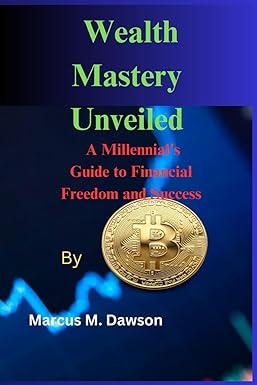You are the founder of CellFree, a cellphone battery and charging unit that allows cellphones to charge wirelessly.
CellFree has been in operation for 2 years. For the first year and a half you were able to self- fund your company with $50,000 which you had saved from working at your previous job. Six months ago, however, you realized that additional outside financing would be necessary to enable your company to keep growing at its current pace.
To obtain this financing you went on AngelList, and secured an investment from South Philly Angels, a well-known local angel group, in the form of $300,000 in convertible notes. These notes carried a 10% annual interest rate, payable at maturity, and would be automatically converted into preferred stock at a 20% discount upon the raising of a Series A financing round. Over the course of the next 6-months you quickly used up these funds.
Realizing that you would soon need new financing you went to work trying to drum up investments from the venture capital community. Within a few weeks, you received term sheets from two VC firms: TruCost Venture Partners and Robin Hood Ventures. TruCost Venture Partners is a well-known venture capital firm located in Silicon Valley. Theyre known for their past successful investments. Theyve recently raised their largest fund to date with $650M in committed capital. Robin Hood Ventures is a smaller, more recently established VC firm located in Philadelphia. Theyve raised $150M for their most recent fund and have had good success in their investments thus far.
Together with your co-founders you need to review each VCs term sheet and decide which offer your firm will take.


1. Construct a Capitalization Table for the Robin Hood Term Sheet Tip: Figure out total shares outstanding post-money (i.e. calculate the number of shares going to the angel investor), and then calculate the size of the option pool Pre-Series A Shares Post-Series A $ % Shares % Shareholder Founder Employee Pool SP Angels - Series A Robin Hood - Series A Other VC - Series A Total $393,750 $3,000,000 $3,000,000 $6,000,000 100% 2. Assume that CellFree is sold at a future date in a Liquidation Event. For each of the exit scenarios below, (a) determine whether or not the Series A holders will exercise their Liquidation Preference or convert to Common Stock and (b) calculate the proceeds available Low Scenario - $10,000,000 Exit (a) What will the the Series A holders do? Proceeds to Series A holders if they Exercise the Liquidation preference Proceeds to Series A holders convert to Common Will Series A holders exercise the liquidation preference or convert to common stock? (b) What will the founders receive? Medium Scenario - $25,000,000 Exit (a) What will the the Series A holders do? Proceeds to Series A holders if they Exercise the Liquidation preference Proceeds to Series A holders convert to Common Will Series A holders exercise the liquidation preference or convert to common stock? (b) What will the founders receive? High Scenario - $100,000,000 Exit (a) What will the the Series A holders do? Proceeds to Series A holders if they Exercise the Liquidation preference Proceeds to Series A holders convert to Common Will Series A holders exercise the liquidation preference or convert to common stock? (b) What will the founders receive? 1. Construct a Capitalization Table for the Robin Hood Term Sheet Tip: Figure out total shares outstanding post-money (i.e. calculate the number of shares going to the angel investor), and then calculate the size of the option pool Pre-Series A Shares Post-Series A $ % Shares % Shareholder Founder Employee Pool SP Angels - Series A Robin Hood - Series A Other VC - Series A Total $393,750 $3,000,000 $3,000,000 $6,000,000 100% 2. Assume that CellFree is sold at a future date in a Liquidation Event. For each of the exit scenarios below, (a) determine whether or not the Series A holders will exercise their Liquidation Preference or convert to Common Stock and (b) calculate the proceeds available Low Scenario - $10,000,000 Exit (a) What will the the Series A holders do? Proceeds to Series A holders if they Exercise the Liquidation preference Proceeds to Series A holders convert to Common Will Series A holders exercise the liquidation preference or convert to common stock? (b) What will the founders receive? Medium Scenario - $25,000,000 Exit (a) What will the the Series A holders do? Proceeds to Series A holders if they Exercise the Liquidation preference Proceeds to Series A holders convert to Common Will Series A holders exercise the liquidation preference or convert to common stock? (b) What will the founders receive? High Scenario - $100,000,000 Exit (a) What will the the Series A holders do? Proceeds to Series A holders if they Exercise the Liquidation preference Proceeds to Series A holders convert to Common Will Series A holders exercise the liquidation preference or convert to common stock? (b) What will the founders receive








